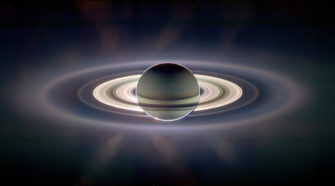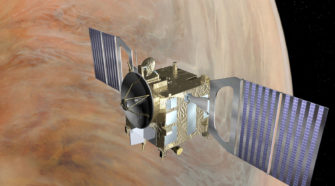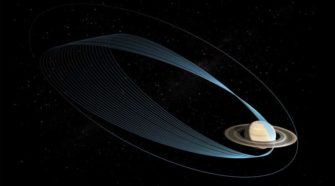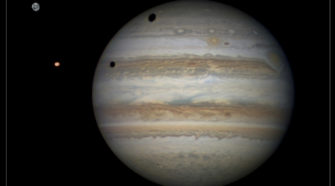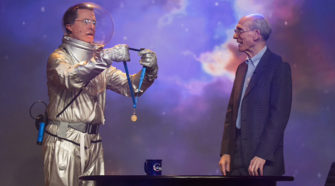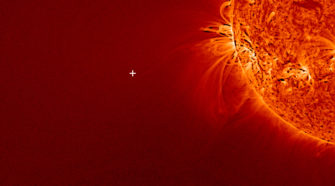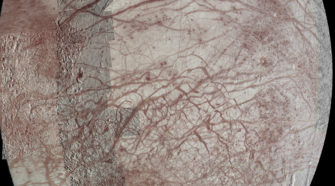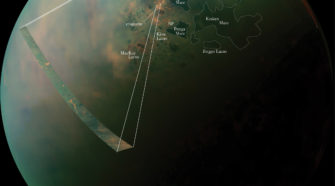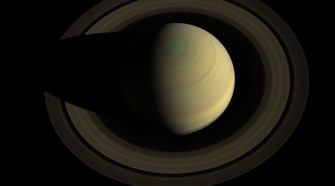Solar System
Cassini at Saturn: A decade exploring the ringed system
Cassini: Amazing images and even more amazing science The Cassini orbiter has been in orbit around Saturn since June 2004. Launched aboard a Titan IVB rocket from Cape Canaveral Air Force Station on October 15, 1997, it was originally dubbed Cassini-Huygens as the Huygens probe was carried along with Cassini to the Saturnian system. The …
Venus Express gets ready to take the plunge
After eight years in orbit, ESA’s Venus Express has completed routine science observations and is preparing for a daring plunge into the planet’s hostile atmosphere. Venus Express was launched on a Soyuz–Fregat from the Russian Baikonur Cosmodrome in Kazakhstan on 9 November 2005, and arrived at Venus on 11 April 2006. It has been orbiting …
‘Club sandwich’ of oceans and ice may exist within Jovian moon
The largest moon in our solar system, a companion to Jupiter named Ganymede, might have ice and oceans stacked up in several layers like a club sandwich, according to new NASA-funded research that models the moon’s makeup. Previously, the moon was thought to harbor a thick ocean sandwiched between just two layers of ice, one …
Join in the Cassini Name Game
As NASA’s Cassini mission approaches its 10th anniversary at Saturn, its team members back here on Earth are already looking ahead to an upcoming phase. Starting in late 2016, the Cassini spacecraft will repeatedly climb high above Saturn’s north pole, flying just outside its narrow F ring. Cassini will probe the water-rich plume of the …
Jupiter: The Gas Giant
Of all the planets that orbit around our Sun there are two that are easily visible and are fascinating objects to view. These are, of course, Saturn and Jupiter. Of these Jupiter is prominent in our night skies at the moment. At magnitude -2.06 it is the third brightest thing in the sky after the …
Stephen Colbert presents honor from NASA to Voyager scientist
As if NASA’s Voyager mission didn’t have enough firsts in its 36-year journey, what with sending the first spacecraft to Uranus, Neptune and, most recently, interstellar space! Now, it has another first back here on Earth: on the December 3, 2013 episode of the Colbert Report, host Stephen Colbert floated across the stage in a …
Comets are unpredictable beasts
The media was full of talk of comets with the inaugural visit of Comet ISON C/2012 S1. It was pre-hyped as being “The Comet of the Century”, being visible in daylight etc, etc. The reality of the matter is that comets are strange beasts and are rarely predictable unless they have been round a few …
Europa likely off-kilter at one time
By analyzing the distinctive cracks lining the icy face of Europa, NASA scientists found evidence that this moon of Jupiter likely spun around a tilted axis at some point. Europa’s tilt could influence calculations of how much of the moon’s history is recorded in its frozen shell, how much heat is generated by tides in …
Titan’s northern lakes resemble Earth’s salt flats
With the sun now shining down over the north pole of Saturn’s moon Titan, a little luck with the weather, and trajectories that put the spacecraft into optimal viewing positions, NASA’s Cassini spacecraft has obtained new pictures of the liquid methane and ethane seas and lakes that reside near Titan’s north pole. The images reveal …
Cassini swings high above Saturn to take a portrait
It’s a view as good as gold. A loop high above Saturn by NASA’s Cassini spacecraft revealed this stately view of the golden-hued planet and its main rings. The observation and resulting image mosaic were planned as one of three images for Cassini’s 2013 Scientist for a Day essay contest. The contest challenges students to …

